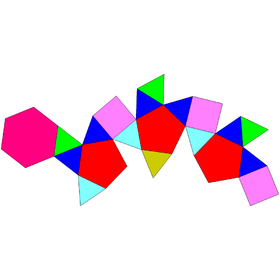Properties
The triangular hebesphenorotunda is named by Johnson (1966), with the prefix hebespheno- referring to a blunt wedge-like complex formed by three adjacent lunes—a figure where two equilateral triangles are attached at the opposite sides of a square. The suffix (triangular) -rotunda refers to the complex of three equilateral triangles and three regular pentagons surrounding another equilateral triangle, which bears a structural resemblance to the pentagonal rotunda. [1] Therefore, the triangular hebesphenorotunda has 20 faces: 13 equilateral triangles, 3 squares, 3 regular pentagons, and 1 regular hexagon. [2] The faces are all regular polygons, categorizing the triangular hebesphenorotunda as a Johnson solid, enumerated the last one  . [3] It is an elementary polyhedron, meaning that it cannot be separated by a plane into two small regular-faced polyhedra. [4]
. [3] It is an elementary polyhedron, meaning that it cannot be separated by a plane into two small regular-faced polyhedra. [4]
The surface area of a triangular hebesphenorotunda of edge length  as: [2]
as: [2]  and its volume as: [2]
and its volume as: [2] 
Cartesian coordinates
The triangular hebesphenorotunda with edge length  can be constructed by the union of the orbits of the Cartesian coordinates:
can be constructed by the union of the orbits of the Cartesian coordinates:  under the action of the group generated by rotation by 120° around the z-axis and the reflection about the yz-plane. Here,
under the action of the group generated by rotation by 120° around the z-axis and the reflection about the yz-plane. Here,  denotes the golden ratio. [5]
denotes the golden ratio. [5]
This page is based on this
Wikipedia article Text is available under the
CC BY-SA 4.0 license; additional terms may apply.
Images, videos and audio are available under their respective licenses.









